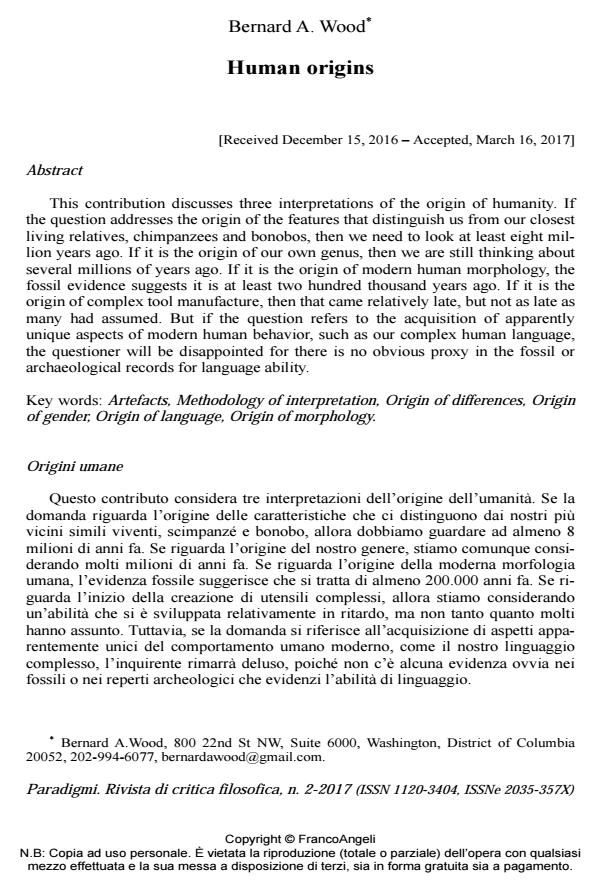Human origins
Titolo Rivista PARADIGMI
Autori/Curatori Bernard A. Wood
Anno di pubblicazione 2017 Fascicolo 2017/2
Lingua Inglese Numero pagine 14 P. 75-88 Dimensione file 343 KB
DOI 10.3280/PARA2017-002006
Il DOI è il codice a barre della proprietà intellettuale: per saperne di più
clicca qui
Qui sotto puoi vedere in anteprima la prima pagina di questo articolo.
Se questo articolo ti interessa, lo puoi acquistare (e scaricare in formato pdf) seguendo le facili indicazioni per acquistare il download credit. Acquista Download Credits per scaricare questo Articolo in formato PDF

FrancoAngeli è membro della Publishers International Linking Association, Inc (PILA)associazione indipendente e non profit per facilitare (attraverso i servizi tecnologici implementati da CrossRef.org) l’accesso degli studiosi ai contenuti digitali nelle pubblicazioni professionali e scientifiche
This contribution discusses three interpretations of the origin of humanity. If the question addresses the origin of the features that distinguish us from our closest living relatives, chimpanzees and bonobos, then we need to look at least eight million years ago. If it is the origin of our own genus, then we are still thinking about several millions of years ago. If it is the origin of modern human morphology, the fossil evidence suggests it is at least two hundred thousand years ago. If it is the origin of complex tool manufacture, then that came relatively late, but not as late as many had assumed. But if the question refers to the acquisition of apparently unique aspects of modern human behavior, such as our complex human language, the questioner will be disappointed for there is no obvious proxy in the fossil or archaeological records for language ability.
Questo contributo considera tre interpretazioni dell’origine dell’umanità. Se la domanda riguarda l’origine delle caratteristiche che ci distinguono dai nostri più vicini simili viventi, scimpanzé e bonobo, allora dobbiamo guardare ad almeno 8 milioni di anni fa. Se riguarda l’origine del nostro genere, stiamo comunque considerando molti milioni di anni fa. Se riguarda l’origine della moderna morfologia umana, l’evidenza fossile suggerisce che si tratta di almeno 200.000 anni fa. Se riguarda l’inizio della creazione di utensili complessi, allora stiamo considerando un’abilità che si è sviluppata relativamente in ritardo, ma non tanto quanto molti hanno assunto. Tuttavia, se la domanda si riferisce all’acquisizione di aspetti apparentemente unici del comportamento umano moderno, come il nostro linguaggio complesso, l’inquirente rimarrà deluso, poiché non c’è alcuna evidenza ovvia nei fossili o nei reperti archeologici che evidenzi l’abilità di linguaggio.
Parole chiave:Artefatti, Metodi interpretativi, Nascita del linguaggio, Origine del genere, Origine di differenze, Origine morfologica.
Bernard A. Wood, Human origins in "PARADIGMI" 2/2017, pp 75-88, DOI: 10.3280/PARA2017-002006